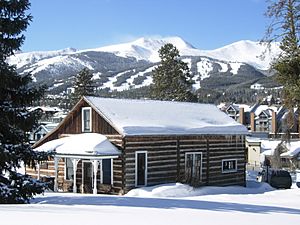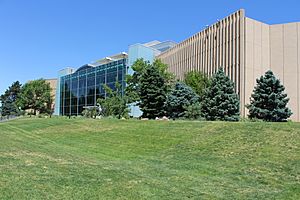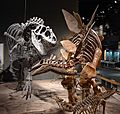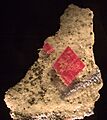Denver Museum of Nature and Science facts for kids

Denver Museum of Nature & Science
|
|
| Established | December 6, 1900 (125 years ago) |
|---|---|
| Location | Denver, Colorado |
| Type | Natural History |
| Visitors | 1,151,000 (2022) |
The Denver Museum of Nature & Science is a cool place in Denver, Colorado. It's a natural history and science museum where you can learn all about Colorado, Earth, and even the universe! The building is huge, about 716,000 square feet. Inside, it holds over a million amazing things. These include items from nature, human history, and lots of old books and records.
The museum is run by a nonprofit group. It has about 450 full-time and part-time staff. Plus, over 1,000 volunteers help out! It's also connected to the famous Smithsonian Institution. In 2022, over 1.1 million people visited the museum. This made it one of the most popular nature and science museums in the U.S. The museum even has its own online magazine called Catalyst.
Learning and Fun Programs
The museum offers many ways to learn. You can explore exhibitions and watch films in the Infinity Theater. There are also lectures, classes, and special programs. These activities cover six main topics. They include:
- Anthropology (the study of humans)
- Geology (the study of Earth's rocks and history)
- Health science (how our bodies work)
- Paleontology (the study of fossils and ancient life)
- Space science (the study of the universe)
- Zoology (the study of animals)
More than 300,000 students and teachers visit the museum each year. The museum also has special science programs for families. They even offer online learning for schools and communities. Teachers can also get special training workshops here.
Museum History
The museum's story began in 1868. A man named Edwin Carter moved to Breckenridge, Colorado. He loved studying the birds and mammals of the Rocky Mountains. He collected one of the best groups of Colorado animals ever seen.
People in Denver heard about Carter's collection. In 1892, they wanted to move it to the city. Carter agreed to sell his whole collection for $10,000. The museum's founders also got collections of butterflies and crystallized gold.
These three collections became the start of the Colorado Museum of Natural History. It officially opened on December 6, 1900. After years of building, the museum welcomed visitors on July 1, 1908. The first president, John F. Campion, said, "A museum of natural history is never finished." Staff were hired to create more exhibits and public programs. By 1918, a new part of the building opened.
In 1927, a museum team made an amazing discovery. They found two stone spear points in an ancient bison in New Mexico. These Folsom points showed that humans lived in North America over 10,000 years ago. This was much earlier than people thought!
The city of Denver gave more money to the museum. So, in 1948, its name changed to the Denver Museum of Natural History. In 2000, it changed again to the Denver Museum of Nature and Science. This new name showed its wider focus on both nature and science.
The museum gets some money from a special district called SCFD. It also gets big gifts from people who support it. For example, the Morgridge Family Foundation gave $8 million in 2010. This was the largest gift since the museum started.
On July 9, 2025, something surprising happened. The museum was drilling a hole in its parking lot. They wanted to see if they could use heat from the Earth. But 763 feet down, they found a piece of a dinosaur fossil! It was likely a bone from a plant-eating dinosaur. The geology curator wanted to dig up the whole parking lot. But he couldn't, because the museum needs its parking spaces.
Cool Permanent Exhibits
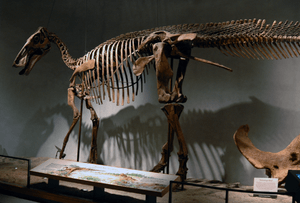
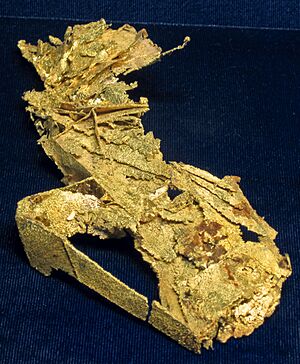
Expedition Health
Expedition Health teaches you about the human body. You can even learn about the science of taste! This exhibit opened on March 30, 2009.
Space Odyssey
Space Odyssey is all about the universe and our place in it. It opened in 2003 and was updated in 2020. A cool part of this exhibit is a full-size copy of a Mars Exploration Rover.
Prehistoric Journey
Prehistoric Journey takes you back in time. It shows how life on Earth has changed over millions of years. You can see skeletons of ancient animals like:
- Dimetrodon
- Eryops
- Allosaurus
- Stegosaurus
- Diplodocus
- Edmontosaurus
- Maiasaura
- And many more!
There's also a display of a sea lily reef from 435 million years ago. You can see a copy of the skull of an ancient fish called Dunkleosteus. Plus, there's a collection of trilobites. A dinosaur bone found under the parking lot in 2025 is also part of this exhibit.
Wildlife Halls
The Wildlife Halls are amazing. They have dioramas that show animals in their natural homes. These are some of the biggest collections of their kind in North America.
Birds of the Americas
This hall shows birds from North and South America. You can see birds from Mexico, Guyana, and different parts of Colorado. Some examples include:
Explore Colorado: From Plains to Peaks
This exhibit focuses on animals found in Colorado. It shows creatures from the plains to the mountains. You might spot:
- Tiger swallowtail butterflies
- Black-billed magpies
- Pronghorn antelope
- Black-tailed prairie dogs
- Bighorn sheep
Northern and Rare Birds
This hall, also known as Birds of North America, features special birds. It includes some rare or extinct species. You can see:
- The extinct Carolina parakeet
- The extinct Passenger pigeon
- The California condor
- Various birds from Alaska like the King eider and Willow ptarmigan
Sketches of South America
This exhibit shows animals from South America. It includes creatures from Brazil and the Galápagos Islands. Look for:
Botswana: Safari to Wild Africa
This hall takes you on a safari to Botswana, Africa. You can see many African animals like:
North America's Bears and Northern Sea Mammals
This exhibit features different types of bears and sea mammals. You can learn about:
- Brown bears and Grizzly bears
- Polar bears
- Walruses
- Different types of seals like the Ringed seal and Northern fur seal
Edge of the Wild
This hall shows animals from different parts of North America. It includes:
North America's Wild Places
This exhibit, also called Scenes of Change, shows animals from various North American habitats. You can see:
Australia and South Pacific
This hall features animals from Australia and the South Pacific islands. Discover creatures like:
One diorama, "Western Brazil," was removed because it wasn't scientifically accurate. It showed animals that don't naturally live together. But you can still find clues about it in the museum!
Insects & Butterflies
This exhibit is all about insects and butterflies. It has four parts:
- Pinning Down Insects: Learn about different insect groups.
- Deceits & Defenses: See how insects protect themselves.
- Colorado Lepidoptera: Discover 171 types of butterflies and moths from Colorado. This includes the Colorado hairstreak, Colorado's state insect!
- Form Follows Function: Explore the life cycle of a mourning cloak butterfly. See beautiful rainforest butterflies, including Morpho butterflies.
Egyptian Mummies
The Egyptian Mummies exhibit has two real mummies. It also features ancient Egyptian coffins and other artifacts. The mummies were scanned in 1991 and 2016 to learn more about them. There's even a small model of an ancient Egyptian temple.
Coors Gems & Minerals
In Coors Gems & Minerals, you can see many colorful crystals and minerals. They come from Colorado and all over the world. There's a re-created mine, like the Sweet Home mine. That's where the Alma King was found. It's the largest rhodochrosite crystal ever found! The museum's oldest exhibit, crystallized leaf gold, is also here. It was given to the museum in 1900.
Konovalenko Gem Carvings
The museum has a special collection of gem carvings. These are made by a Ukrainian artist named Vasily Konovalenko. This is the only public collection of his work outside of Moscow. You can find it on the third floor.
Ancient Denver
Ancient Denver is a series of paintings. They show what the Denver area looked like from 300 million years ago until today.
Around the museum, you can also see some huge skeletons. There's a Tyrannosaurus rex, two Thalassomedon (ancient sea reptiles), and a fin whale. There's also a copy of the Chief Kyan totem pole. On the first floor, you can even see a display that shows how escalators work!
Research and Collections
The museum isn't just for visitors. It's also a place for important research! Scientists study the huge collections here.
- The Anthropology Collection has over 50,000 objects. These are artifacts from North, Central, and South America, Africa, Asia, and Oceania.
- The Earth Sciences Collection includes fossils of animals and plants, minerals, and meteorites.
- The Health Sciences Collection has rare human anatomy specimens.
- The Space Sciences Lab has scientific instruments. They also have a huge collection of digital images and videos about space.
- The Zoology Collection is massive! It has over 900,000 animal specimens. This includes spiders, insects, shells, birds, and mammals. Some are even from species that are now extinct.
- The Bailey Library and Archives has over 53,000 books and scientific journals. They focus on all the museum's topics.
Special Temporary Exhibits
The museum often brings in special exhibits from other museums. These usually stay for about six months. Some past exhibits include:
- Maya: Hidden Worlds Revealed: This exhibit explored the art, culture, and history of the ancient Maya people.
- Whales: Giants of the Deep: This exhibit came from New Zealand. It featured whale skulls, skeletons, and videos.
- Traveling the Silk Road: This exhibit showed artifacts from the ancient trade route between China and Istanbul.
Gates Planetarium
The Gates Planetarium is a special theater with 125 seats. The seats lean back, and you get amazing surround sound. The dome is 56 feet wide and tilted. It's a great place to learn about stars and planets! This planetarium replaced an older one.
Infinity Theater
The Infinity Theater is on the second floor. It was built in 1940 as the Phipps Auditorium. It used to host lectures, concerts, and films. In 1983, it became the Phipps IMAX Theater. It seats 440 people and shows large movies every day. In July 2022, it closed for updates. It reopened in February 2023 with a new name, "Infinity Theater." It's now a super modern theater for all kinds of visual fun!
Exploration and Collections Centers
In 2014, the museum added a big new section. It cost $70 million! This new part includes the Morgridge Family Exploration Center and the Avenir Collections Center.
The Morgridge Family Exploration Center has three levels above ground. It helps visitors learn about science and nature. It has:
- Exploration Studios
- A new gallery for temporary exhibits
- A special "Discovery Zone" for younger kids
- An outdoor area called Boettcher Plaza with unique art
The Avenir Collections Center is underground. It's a special place that keeps nearly 1.5 million artifacts and specimens safe. It has two underground levels and is climate-controlled. It holds things like:
- Bison from the 1870s
- Extinct passenger pigeons
- The last Grizzly bear killed in Colorado (in 1979)
- And even animals found as roadkill!
All the information about these items is put into online databases.
Museum Secrets
The museum has some fun hidden secrets! You can find scavenger hunts on the Denver Museum website. These hunts help you look for special "Museum Treasures." One of the museum's diorama painters, Kent Pendleton, hid eight elves in his artwork. Visitors are encouraged to find them using the scavenger hunts!
Gallery
-
Tyrannosaurus rex skeleton located at the museum entrance
-
A Stegosaurus stenops and an Allosaurus fragilis from the Prehistoric Journey exhibit
-
A Dimetrodon limbatus and an Eryops megacephalus
-
Wapiti Elk from a diorama
-
Mountain Lion diorama
-
Bighorn sheep diorama
-
The Museum's famous 1942 Polar bear diorama, featuring a ringed seal
-
Diorama featuring Grizzly bears at Chimney Rock; Grizzlies have not been extant in Colorado since 1979
-
Plains Zebras and a Steenbok in a diorama from the 'Botswana' exhibit
-
Passenger Pigeons from Johnson County, Iowa in this 1890s scene in a diorama featuring the now extinct bird
-
A Bearded seal, a Ringed seal, and two Spotted seals from a portion of a diorama from the Bering Strait near the Diomede Islands
-
A diorama featuring two southern cassowaries
-
Comparison of skulls from a normal Grizzly bear and its Alaska subspecies
-
Display of assorted Darwin's finches
-
Diorama from the 'North American Indian Cultures' exhibit, depicting a group of Cheyenne Indians in the 1860s near modern-day Denver
See Also
- List of landmarks of Denver
- List of museums in Colorado
- Snowmastodon site


